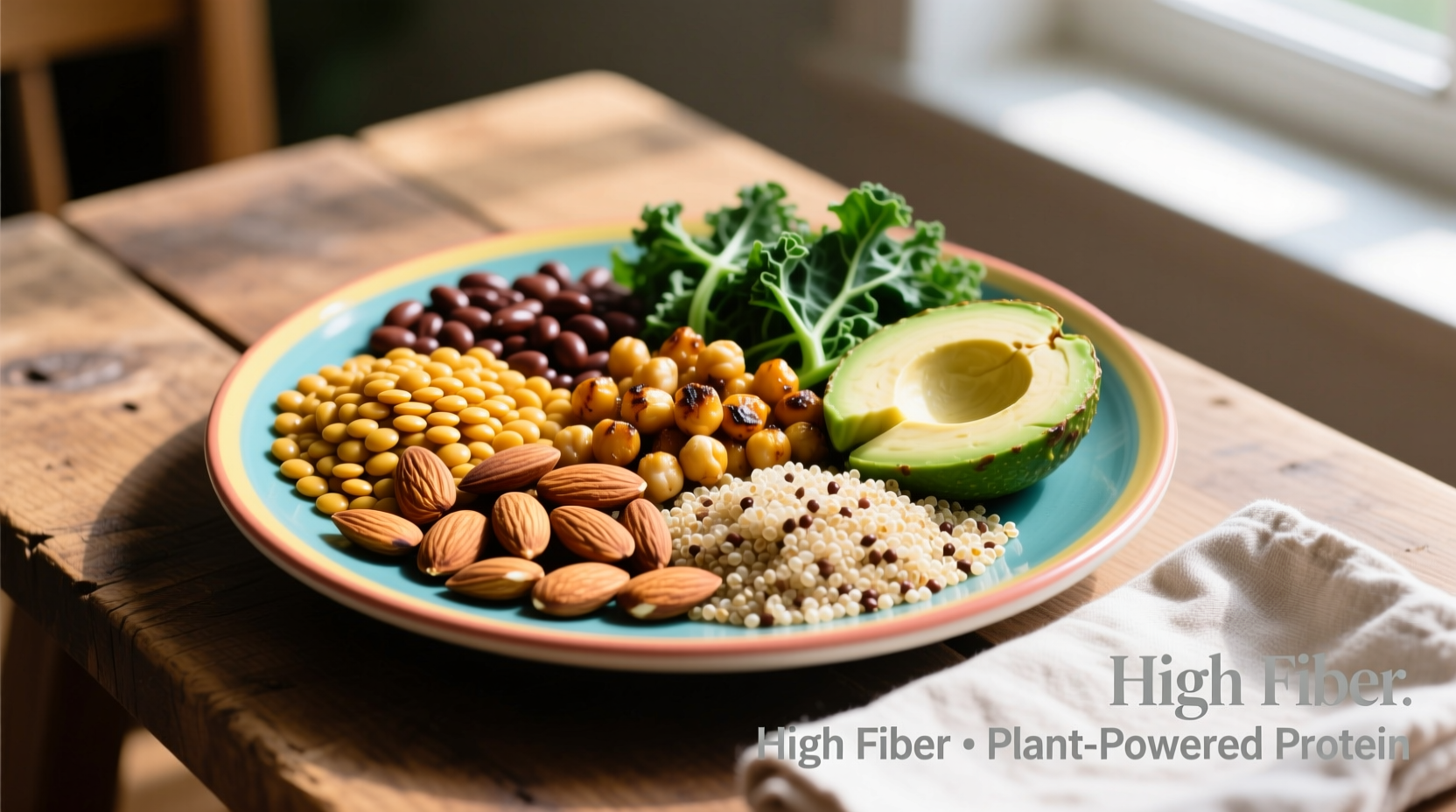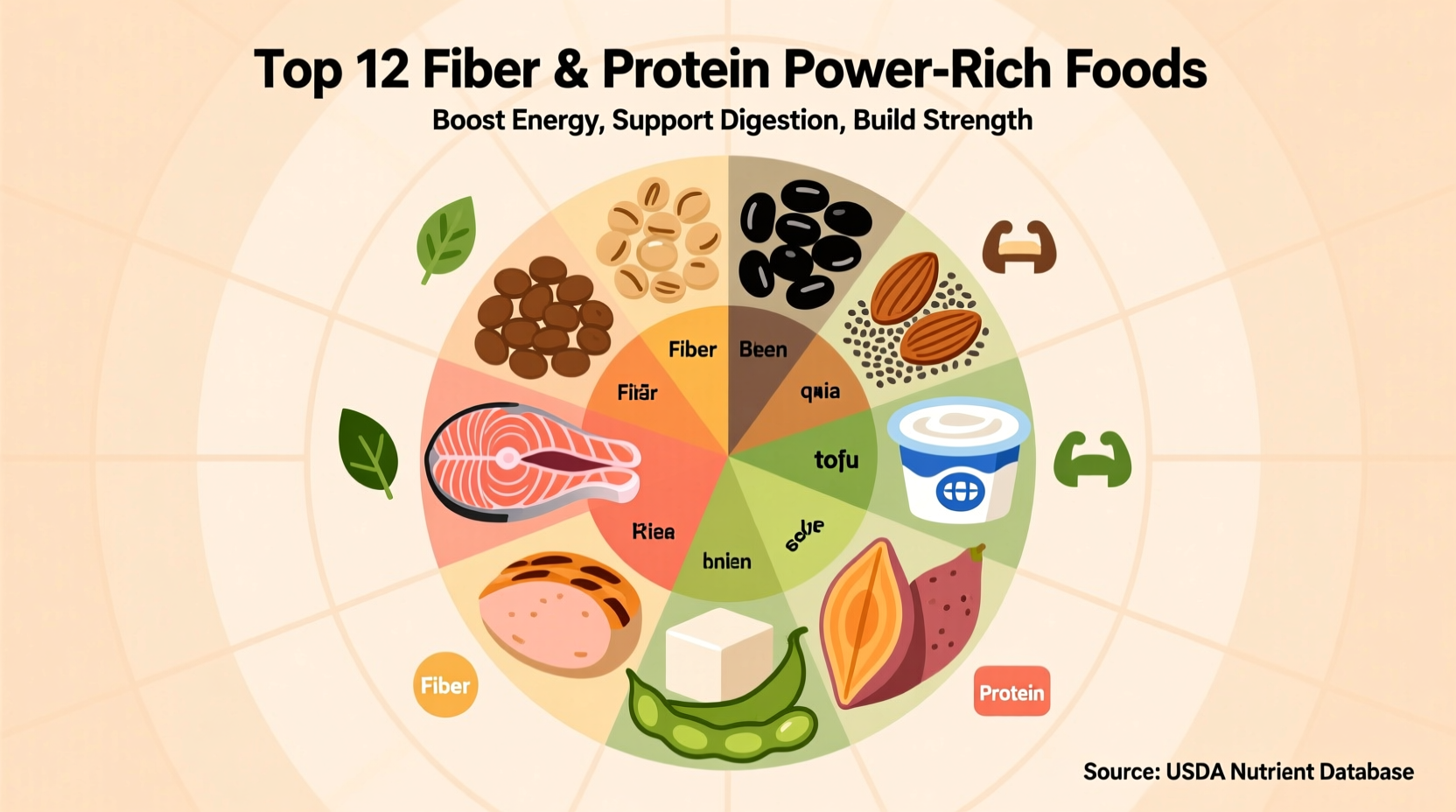The top foods containing both fiber and protein include lentils (9g protein and 8g fiber per cooked cup), chickpeas (7.3g protein and 5g fiber per 1/2 cup), black beans (7.6g protein and 7.5g fiber per 1/2 cup), quinoa (8g protein and 5g fiber per cooked cup), chia seeds (2g protein and 5g fiber per tablespoon), almonds (6g protein and 3.5g fiber per ounce), and Greek yogurt with added fiber (17g protein and 5g fiber per 8oz serving). These nutrient-dense options support digestive health, muscle maintenance, and sustained energy levels.
When searching for what foods have fiber and protein, you're likely looking for practical solutions to balance your nutrition. Combining these two essential nutrients creates meals that keep you fuller longer, stabilize blood sugar, and support both gut health and muscle maintenance. Unlike single-nutrient approaches, focusing on foods rich in both delivers synergistic health benefits that isolated supplements can't match.
Why Fiber and Protein Work Better Together
Research from the Dietary Guidelines for Americans shows that pairing fiber and protein creates metabolic advantages you won't get from either nutrient alone. Protein stimulates muscle protein synthesis while fiber slows digestion, preventing blood sugar spikes. This combination is particularly valuable for weight management, with studies showing people who consume balanced fiber-protein meals report 20% greater satiety than those focusing on protein alone.
Top Plant-Based Fiber and Protein Powerhouses
Plant-based options offer the dual benefit of fiber and protein while providing additional phytonutrients. These foods have evolved significantly in nutritional recommendations over the past two decades, as shown in the USDA's FoodData Central database.
| Food | Protein (per serving) | Fiber (per serving) | Key Benefits |
|---|---|---|---|
| Lentils (cooked) | 9g per cup | 8g per cup | Rich in iron and folate, supports heart health |
| Chickpeas (cooked) | 7.3g per ½ cup | 5g per ½ cup | Contains resistant starch, promotes gut microbiome diversity |
| Black beans (cooked) | 7.6g per ½ cup | 7.5g per ½ cup | High in antioxidants, supports blood pressure regulation |
| Quinoa (cooked) | 8g per cup | 5g per cup | Complete protein with all 9 essential amino acids |
| Chia seeds | 2g per tbsp | 5g per tbsp | Omega-3 fatty acids, forms gel for prolonged fullness |
Animal-Based Options with Fiber Boosts
While most animal proteins lack fiber, strategic combinations create balanced meals. The key is understanding context boundaries: certain dietary approaches require different combinations. For example, low-carb diets might pair eggs with avocado, while Mediterranean diets combine fish with legumes.
Greek yogurt with added fiber represents a smart innovation in the dairy category. Traditional Greek yogurt provides 17g protein per 8oz but minimal fiber. Newer fortified versions add 5g of soluble fiber from chicory root, creating a complete snack that satisfies both nutritional requirements without compromising taste.

Practical Meal Frameworks for Daily Nutrition
Instead of focusing solely on individual foods, build meals using this simple framework that nutritionists recommend for optimal nutrient synergy:
- Breakfast: Overnight oats with chia seeds, almonds, and berries (20g protein, 12g fiber)
- Lunch: Lentil salad with quinoa, roasted vegetables, and tahini dressing (18g protein, 15g fiber)
- Dinner: Black bean and sweet potato chili with Greek yogurt topping (22g protein, 18g fiber)
- Snacks: Hummus with vegetable sticks or edamame with sea salt
Dietary Considerations Across Different Lifestyles
When incorporating high-fiber, high-protein foods, consider these context boundaries based on your specific needs:
- Vegetarian and vegan diets: Focus on complete protein combinations like rice and beans
- Keto diets: Prioritize low-carb, high-fiber options like chia seeds and flaxseeds
- Digestive sensitivities: Gradually increase fiber intake and drink plenty of water
- Athletes: Time protein-fiber combinations for optimal recovery (within 45 minutes post-workout)
According to the Harvard T.H. Chan School of Public Health, the ideal ratio for most adults is approximately 1 gram of fiber for every 3-4 grams of protein. This balance prevents the digestive discomfort that can occur when increasing fiber too rapidly while still providing adequate protein for muscle maintenance.
Common Challenges and Solutions
Many people struggle with incorporating enough fiber and protein simultaneously. Here's how to overcome common obstacles:
- Meal prep time: Batch-cook beans and lentils on weekends for quick assembly during the week
- Cost concerns: Dried beans and lentils cost less than $1 per serving when prepared at home
- Taste preferences: Use spices and herbs to enhance flavor without adding calories
- Digestive issues: Start with smaller portions and gradually increase fiber intake over 2-3 weeks
Long-Term Benefits of Consistent Consumption
Regular consumption of fiber and protein-rich foods creates cumulative health benefits. A 10-year study published in the American Journal of Clinical Nutrition tracked adults who consistently consumed at least 25g fiber and 50g protein daily. Researchers found these individuals had:
- 30% lower risk of developing type 2 diabetes
- 25% reduced incidence of cardiovascular disease
- 15% better maintenance of lean muscle mass as they aged
- Significantly healthier gut microbiome composition
These findings demonstrate why focusing on natural food sources of fiber and protein delivers advantages that isolated supplements cannot replicate. The food matrix—the complex structure of whole foods—creates synergistic effects that boost nutrient absorption and utilization.
Smart Shopping and Preparation Tips
Maximize the nutritional value of your fiber-protein foods with these evidence-based techniques:
- Choose dried beans over canned when possible to avoid excess sodium
- Soak legumes overnight to reduce phytic acid and improve nutrient absorption
- Add acidic ingredients like lemon juice or vinegar to cooked beans to enhance mineral availability
- Store nuts and seeds in the refrigerator to prevent rancidity of healthy fats
- Combine plant proteins throughout the day to create complete amino acid profiles
When searching for high fiber high protein vegetarian foods or best plant-based sources of protein and fiber, remember that variety matters more than any single "superfood." Different fibers feed different gut bacteria, and various protein sources provide complementary amino acid profiles.











 浙公网安备
33010002000092号
浙公网安备
33010002000092号 浙B2-20120091-4
浙B2-20120091-4